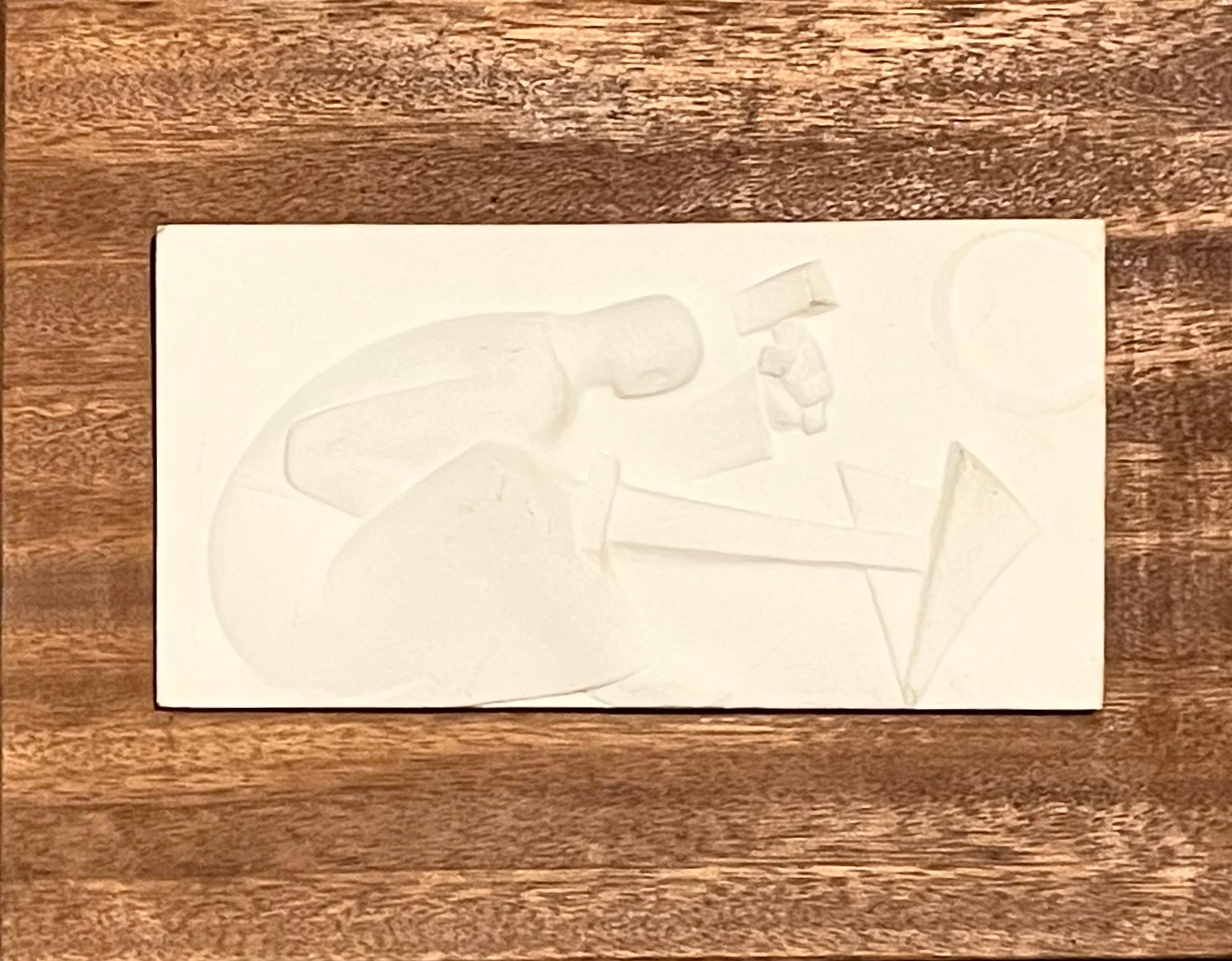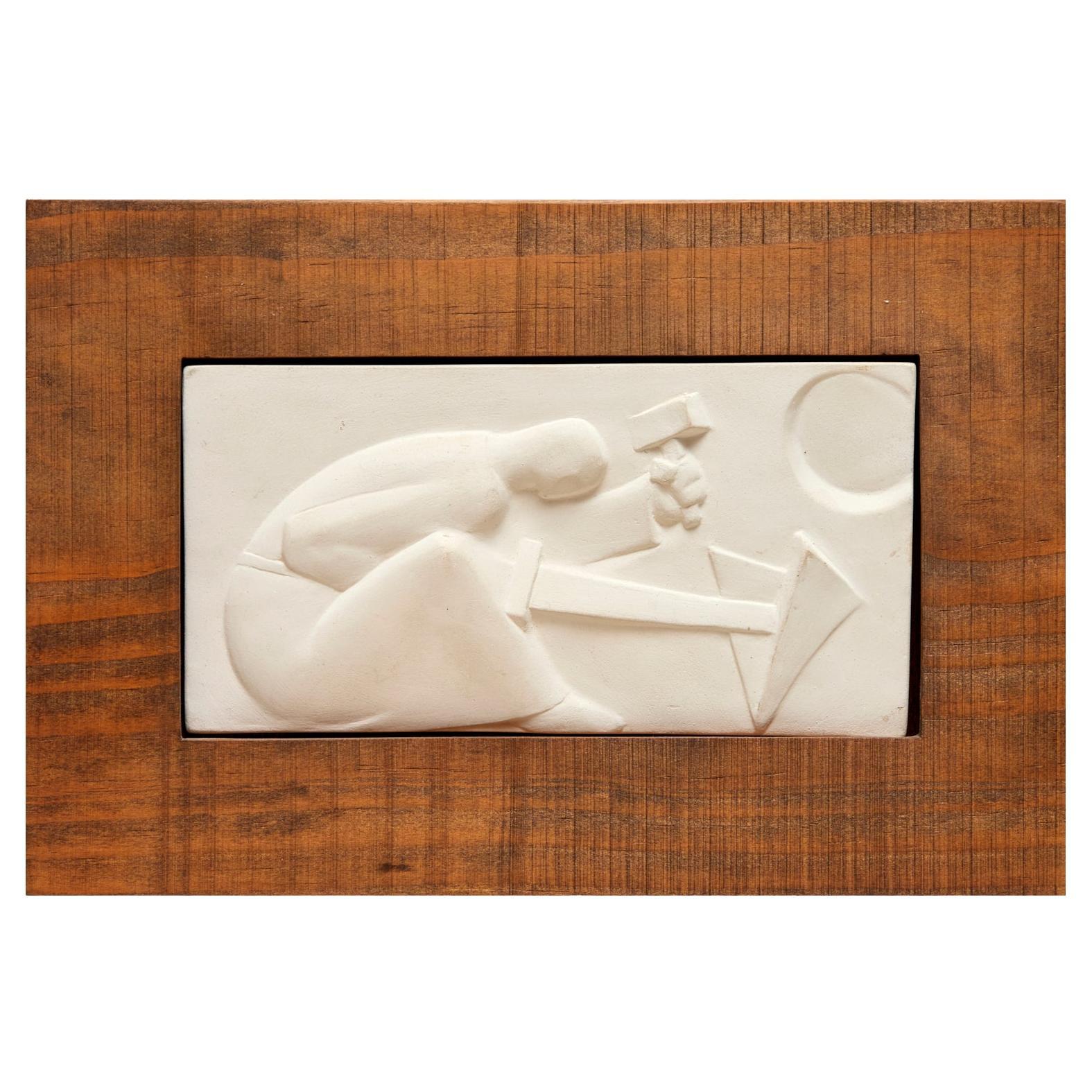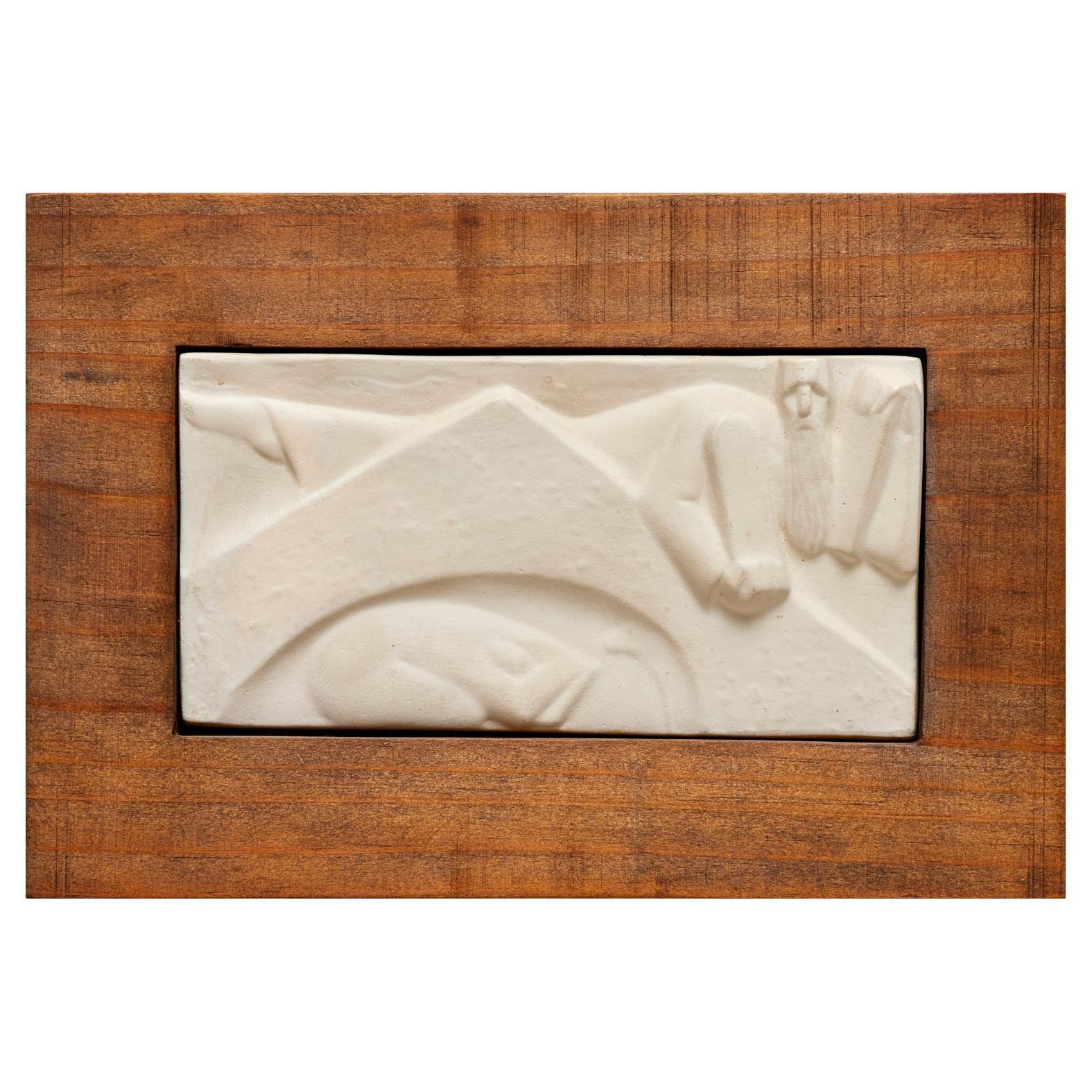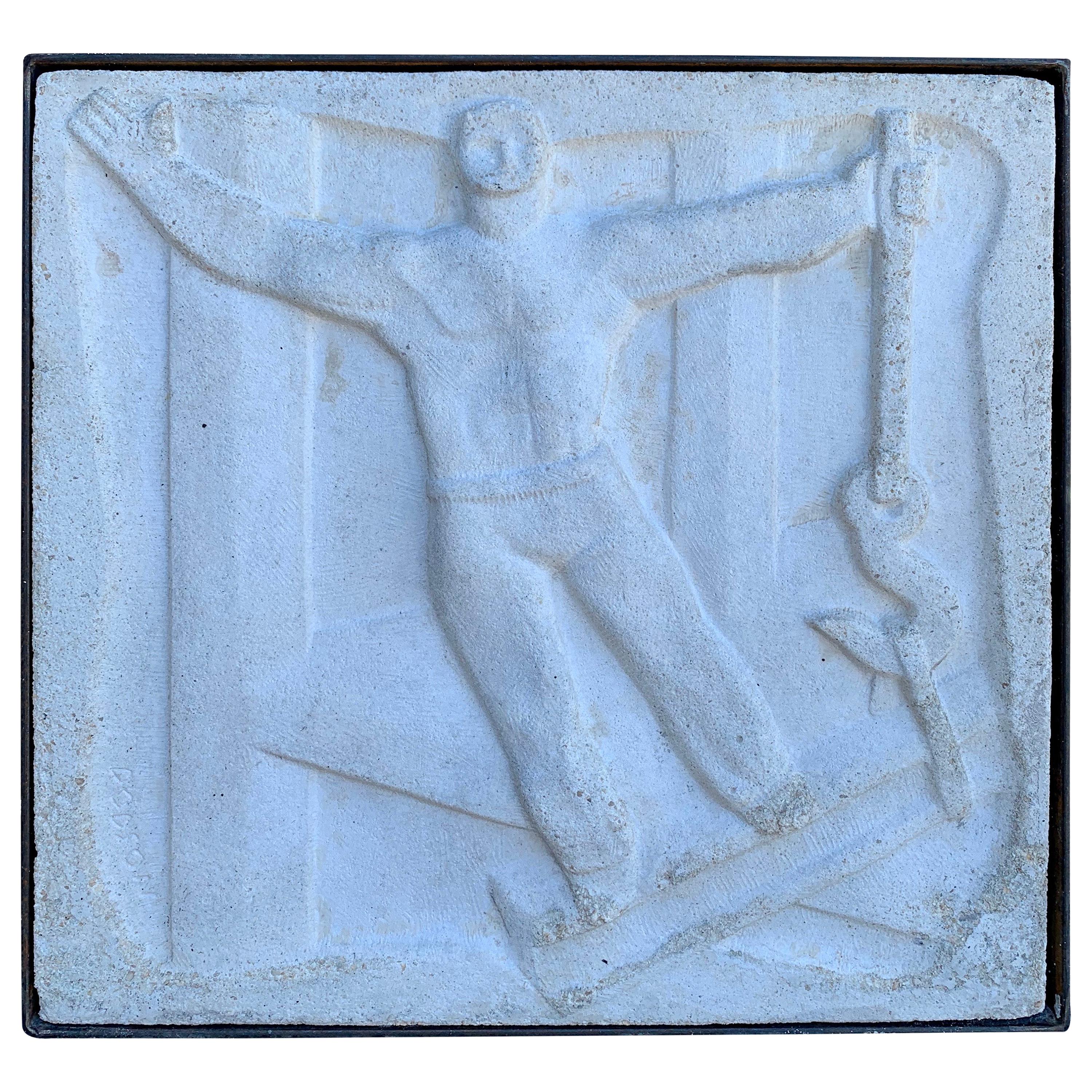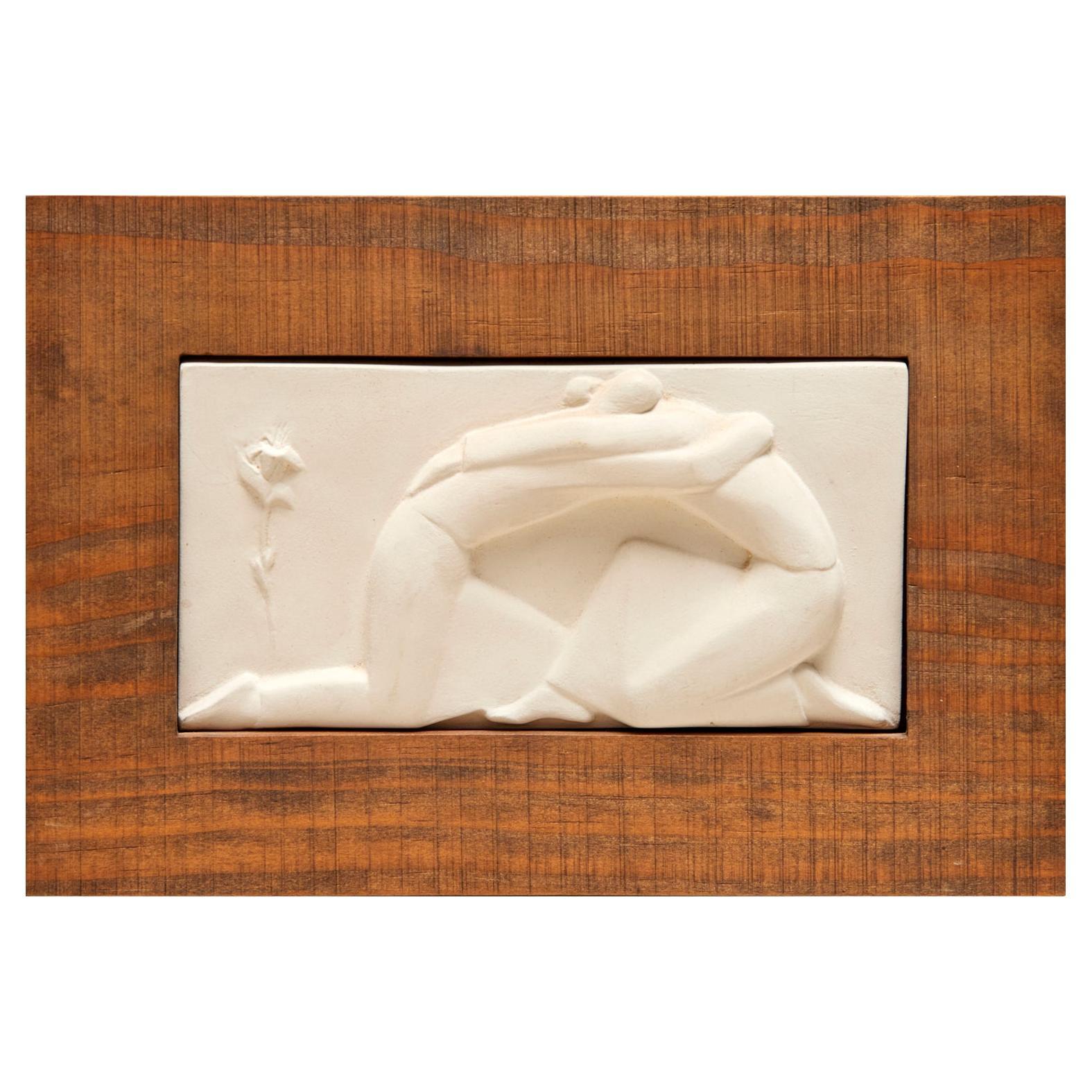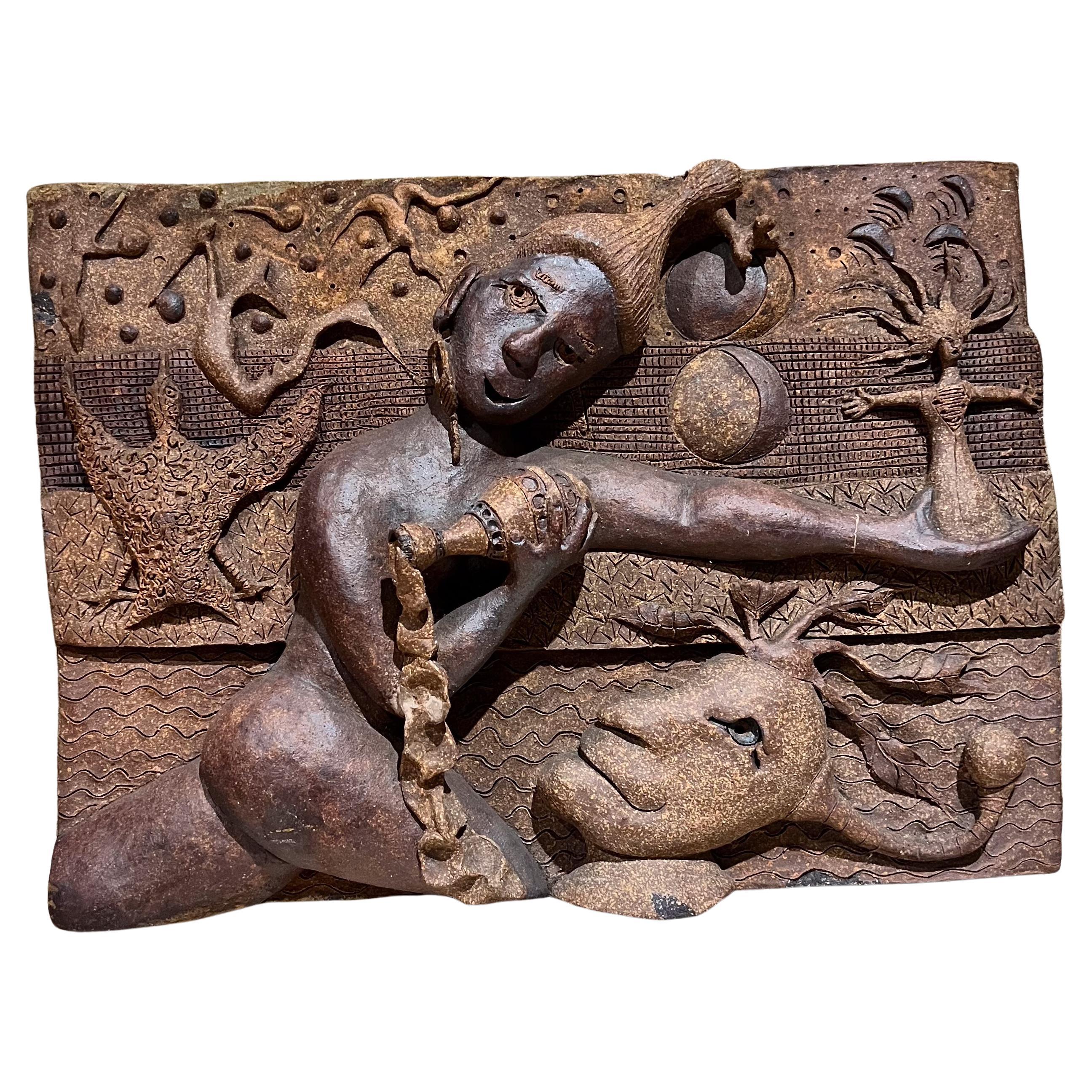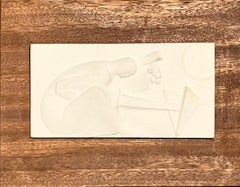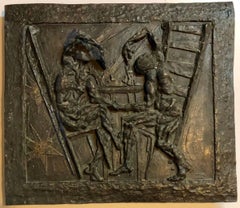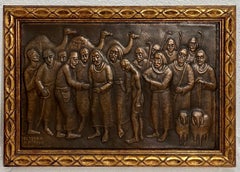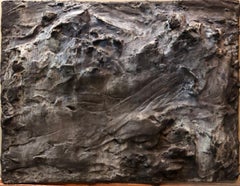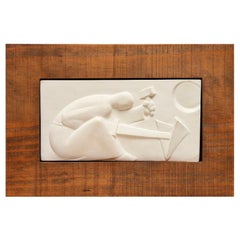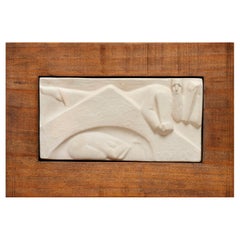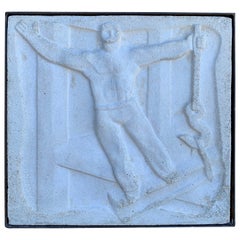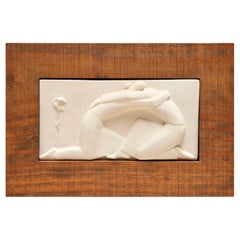Items Similar to Large George Aarons Terracotta Sculpture Relief Art Deco Plaque WPA Artist
Want more images or videos?
Request additional images or videos from the seller
1 of 11
George AaronsLarge George Aarons Terracotta Sculpture Relief Art Deco Plaque WPA Artistc.1930's -1940's
c.1930's -1940's
$2,200
£1,653.82
€1,917.30
CA$3,071.54
A$3,440.29
CHF 1,790.10
MX$41,782.08
NOK 22,693.88
SEK 21,413.37
DKK 14,305.79
Shipping
Retrieving quote...The 1stDibs Promise:
Authenticity Guarantee,
Money-Back Guarantee,
24-Hour Cancellation
About the Item
Two Figures (Mother and son)
9" x 17" terracotta sculpture, signed lower left mounted to wood panel, 15 1/2" x 23 1/2"
George Aarons (born Gregory Podubisky, in St. Petersburg, Russia, 1896 - died in Gloucester, Massachusetts 1980) was a distinguished sculptor who lived and taught in Gloucester, Massachusetts, for many years until his death in 1980. He had, many students in the area and he designed Gloucester's 350th Anniversary Commemorative Medal.
Aarons moved from Russia to the United States when he was ten. His father was a merchant. He began taking drawing classes during evenings at Dearborn Public School in Boston as a teenager and went on to study at the Boston Museum of Fine Arts in 1916. Aarons later moved to New York City to study with Jo Davidson, and other Paris-trained masters at the Beaux-Arts Institute. He eventually returned to the Boston area and established studios in Brookline and Gloucester, Massachusetts. During his lifetime, he was recognized internationally and won several prestigious awards. Aarons had studios in Brookline, Massachusetts and Gloucester, Massachusetts where he produced large bronze and marble figures and wood carvings in the Streamline Moderne style. He produced several projects for the Works Progress Administration including a group of three figures for the Public Garden (Boston), a longshoreman, fisherman and foundry worker, as well as a large relief (1938) for the South Boston Housing Project and façade of the (Jewish) Baltimore Hebrew Congregation Building (1956).
His works are at the Museum of Art in Ein Harod, Israel; Fitchburg Art Museum in Massachusetts, Musée de St. Denis in France; Hilles Library at Radcliffe College in Cambridge, Massachusetts; and Hillel House at Boston University in Massachusetts.
He did reliefs for Siefer Hall at Brandeis University in Waltham, Massachusetts (1950); Edward Filene (the founder of Filene's Department Store and a philanthropist) on the Boston Common; Fireman's Memorial in Beverly, Massachusetts; a memorial to Mitchell Frieman in Boston; the U.S. Post Office in Ripley, Mississippi; and at the Cincinnati Telephone Building; the Combined Jewish Philanthropies building in Boston (1965); and a commemorative medal for the 350th Anniversary of the City of Gloucester, Massachusetts (1972).
Characteristic of his era, George Aarons was among the foreign-born American sculptors of the early 20th century who started their careers as academicians and evolved into modernists and increasingly abstract artists.
Over thirty pieces spanning the length of this sculptor's career were featured in this exhibition, including work in various medium bronze, wood and original plaster and clay. Like his contemporaries, Aarons experimented with direct wooden carving, and he was one of the few academically trained sculptors who consistently cut his own works in marble. His early work was classically inspired figurative work, along with sensitive portraits. Some of his most powerful sculpture comes from his middle period, when he worked through his emotional pain following the global realization of the Jewish Holocaust. His work calls to mind the raw emotional intensity of the works of German artist Kathe Kollwitz of that period. He depicted humanity deep anxiety over this tragedy with figures that are at once symbolically charged and movingly beautiful. Aarons late work consists of radically simplified forms that continue to reference the human form and often are carved directly in wood and stone.
Aarons summered and taught classes on Cape Ann for many years before moving to Gloucester full-time with his wife about 1950. While Aarons is best known locally for his domestic-scale works, he also executed numerous monumental, public commissions that can be found throughout the United States in cities such as Washington, D.C.; Baltimore, Maryland; and Cincinnati, Ohio; as well as in France and Israel.
As noted in a Gloucester Daily Times Article, Aarons wanted his sculptures to honor the struggles and nobility of people and rail against the evil done against them. And that was why, even as his work grew more and more abstract, stylized and simplified, he never left behind the form of the human figure that had been his focus from his earliest works.
Aarons told the Gloucester Daily Times in September 1954 that he found it hard to remember at just what age he started studying art, but he recalled that the nude model had to partially dress when he was in class because he was so young. He initially studied painting and drawing at the museum school, but he once said he became fascinated by sculpture when he met an established sculptor at the Copley Society in Boston who invited Aarons to his studio and offered him some clay to "play around" with.
After he graduated, he apprenticed under sculptors Richard Brooks, Robert Baker and Solon Borglum. He worked as a carpenter, shipbuilder, dishwasher and chimney sweep. He fashioned architectural decorations, including figures for fountains and now and then a few commissioned portraits. He returned to Boston by the early 1920s and began to exhibit his own works and get commissions for portraits, fountains and reliefs.
His sculptures from this time are dreamy and romantic in the realistic, academic style of the time. A painted portrait of the young Aarons that is included in the North Shore Arts Association exhibit shows a determined fellow with dark brown hair, a suit and bow tie. However, in 1922, this determined young artist was living with his parents on Calder Street in Dorchester.
In the 1930s, Aarons adopted the streamlined, monumental style of the socialist works of the time. Aarons made money, as he would all his life, from commissions, selling his personal work and teaching sculpture, but the Depression of the 1930s was tough for everyone.
So Aarons found work though the federal Works Progress Administration, one of Franklin Roosevelt's New Deal programs. He received his first major commission when he was asked to create a public sculpture for the South Boston Harbor Village public housing project around 1937. He was elevated to the position of supervisor for the project and received a corresponding $5 pay increase to make his weekly salary $32. The raise convinced him he was fit to marry and he proposed to Gertrude Band, an attractive brunette dancer whom he had been dating for more than a year. They were married before the Harbor Village project was dedicated on Labor Day 1938.
Aarons' design featured a brawny, larger-than-lifesize fisherman, longshoreman and a laborer flanked by a boy and girl at either end to portray the children who would live in the apartments. Aarons elected to do the piece in cast stone to employ carpenters and laborers as well as craftsman for a total of 10 men.
In his sculpture, Aarons focused more and more on the theme of oppressed people as he worried about the spread of fascism and Nazi socialism during the 1930s, World War II and after. He had done pieces during the mid-1930s about the oppression of African-Americans, including "Negro Head," which is in the North Shore Art Association retrospective. After the war, he also delved into Judaica and Jewish themes and became increasingly known as an important Jewish artist, leading to commissions from Jewish organizations across the country and abroad.
"He gets into raw emotion. Some people describe him as an expressionist because of the emotion (in his work)," Reynolds says.
But Aarons, also sculpted sensual sexual nudes, like Adolescence of 1948, also at the Cape Ann Historical Museum and several in the North Shore Art Association retrospective. Leonard Baskin, Stuart Davis, Hugo Gellert, William Gropper, George Grosz, Jack Levine, Alice Neel, Ben Shahn, Raphael Soyer
Harry Sternberg and Lynd Ward all exhibited with him.
Aarons' sculptures grew increasingly stylized. He depicted people beaten down and writhing in pain, but he focused more and more on the abstract shape and structure of pieces. He often retained the shape of the original block of wood, marble or limestone in the finished pieces.
In 1953, Aarons received a commission to carve a series of reliefs into limestone blocks on the facade of the Baltimore Hebrew Congregation in Maryland.
The most remarkable part of the work is his depiction of the Ten Commandments in two tall tablets. He symbolized the first five, which deal with people's duties to God, with a group of flames climbing up the tablet. He symbolized the next five commandments, which deal with people's duties to each other, with a clod-like texture across the tablet.
Aarons was not a religious man, despite the Jewish subjects in his work.
"I talk in wood, stone or bronze." His statue of Thomas Jefferson decorated the office of the secretary of the treasury in Washington, D.C. His memorial to Edward A. Filene sat in Boston Common. He was commissioned by the city of Gloucester to design a medal to commemorate the city's 350 anniversary in 1972. He had exhibited at the Boston Museum of Fine Arts, Whitney Museum in New York, Dallas Museum of Art in Texas, Cleveland Museum of Art in Ohio, and Corcoran Gallery of Art in Washington, D.C. Locally, his works are on display at the Sawyer Free Library in Gloucester and Manchester Town Hall.
- Creator:
- Creation Year:c.1930's -1940's
- Dimensions:Height: 15.5 in (39.37 cm)Width: 23.5 in (59.69 cm)Depth: 1 in (2.54 cm)
- Medium:
- Movement & Style:
- Period:
- Condition:minor surface wear commensurate with age.
- Gallery Location:Surfside, FL
- Reference Number:1stDibs: LU38212429332
About the Seller
4.9
Platinum Seller
Premium sellers with a 4.7+ rating and 24-hour response times
Established in 1995
1stDibs seller since 2014
1,777 sales on 1stDibs
Typical response time: <1 hour
- ShippingRetrieving quote...Shipping from: Surfside, FL
- Return Policy
Authenticity Guarantee
In the unlikely event there’s an issue with an item’s authenticity, contact us within 1 year for a full refund. DetailsMoney-Back Guarantee
If your item is not as described, is damaged in transit, or does not arrive, contact us within 7 days for a full refund. Details24-Hour Cancellation
You have a 24-hour grace period in which to reconsider your purchase, with no questions asked.Vetted Professional Sellers
Our world-class sellers must adhere to strict standards for service and quality, maintaining the integrity of our listings.Price-Match Guarantee
If you find that a seller listed the same item for a lower price elsewhere, we’ll match it.Trusted Global Delivery
Our best-in-class carrier network provides specialized shipping options worldwide, including custom delivery.More From This Seller
View AllPlaster Sculpture Relief Art Deco Plaque WPA Artist Peace Swords to Ploughshares
By George Aarons
Located in Surfside, FL
Size includes wood mounting.
George Aarons (born Gregory Podubisky, in St. Petersburg, Russia, 1896 - died in Gloucester, Massachusetts 1980) was a distinguished sculptor who lived ...
Category
20th Century Art Deco Figurative Sculptures
Materials
Plaster, Wood
Large Bronze Bas Relief Danse Macabre Expressionist Sculpture Totentantz
Located in Surfside, FL
We have not located any markings on the piece and it does not appear to be signed. it bears similarities with works by Wilfredo Lam and other Cuban and Latin American masters and it ...
Category
Early 20th Century Expressionist Figurative Sculptures
Materials
Bronze
Large Judaica Copper Repousse Sculpture Relief Plaque Arie Merzer Bezalel Era
By Arieh Merzer
Located in Surfside, FL
Arieh Merzer (Israeli, 1905-1966)
Copper relief sculpture panel in gilt frame
Framed dimensions 18 X 26.25, copper 14.5 X 22.5
Arieh Merzer ...
Category
Mid-20th Century Figurative Sculptures
Materials
Metal, Copper
Beverly Pepper Large Bronze Wall Relief Plaque Heavily Textured Woman Artist
By Beverly Pepper
Located in Surfside, FL
Beverly Pepper is an American sculptor known for her monumental works, site specific and land art. She remains independent from any particular art movement. She was married to the writer Curtis Bill Pepper.
Pepper was born Beverly Stoll on December 20, 1922, in Brooklyn, New York. At sixteen, she entered the Pratt Institute in Brooklyn, New York to study advertising design, photography, and industrial design. She then embarked on a career as a commercial art director. She studied at Art Students' League and attended night classes at Brooklyn College, including art theory with György Kepes, who introduced her to the work of Lasló Moholy-Nagy and Man Ray. It was also at this time, in her mid twenties, that she met the environmental artist Frederick Kiesler. Drawn to post-war Europe in 1949, she studied painting in Paris at the Académie de la Grande Chaumière. There she attended classes with cubist painter André L'Hôte, and with Fernand Léger at his atelier. She also visited the studios of Ossip Zadkine and Brâncuși.
Pepper began her career as a painter, but after a trip to Angkor Wat, Cambodia in 1960, she was so awed by the temple ruins surviving beneath the jungle growth that she turned to sculpture. She made her debut in 1962 with an exhibit of carved tree trunks at a gallery in Rome. After several exhibitions in New York and Rome, she was one of ten artists invited by Giovanni Carandente, along with David Smith, Alexander Calder, Arnaldo Pomodoro, Lynn Chadwick, and Pietro Consagra, to fabricate works in Italsider factories in Italy for an outdoor exhibition, "Sculture nella città", held in Spoleto during the summer of 1962. Beverly Pepper has had a long and extraordinary career. Like her contemporaries Louise Bourgeois and Louise Nevelson, Pepper forged a unique path as a mid-century feminist artist. As the 1960s progressed, Pepper turned to polished stainless steel. In some of the first works, she used a torch to carve used one-inch thick elements of stainless steel. From there, her pieces evolved into highly polished stainless with painted interiors. She was, in fact, one of the first artists, if not the first, to incorporate Cor-Ten steel into sculpture. Beginning in the 1970s, and to the present day, she has lived a bi-continental life traveling between Europe and the United States.
Western Washington University outdoor sculpture collection. The collection has some pieces which qualify as "land art" including Alice Aycock's 1987 "The Islands of the Rose Apple Tree Surrounded by the Oceans of the Word, for You, Oh My Darling," and Nancy Holt's 1977-1978 "Stone Enclosure: Rock Rings." Other artists in the collection include Beverly Pepper, Robert Morris, Richard Serra, Isamu Noguchi, Bruce Nauman, Tom Otterness, and Mark di Suvero.
Pepper's works have been exhibited and collected by major museums and galleries throughout the world, including:
deCordova Sculpture Park and Museum, Lincoln, Massachusetts
The Metropolitan Museum of Art, New York
The Whitney Museum of American Art, New York
Brooklyn Museum of Art, Brooklyn, New York
The Albright-Knox Art Gallery, Buffalo, New York
The White House Sculpture Garden, Washington, D.C.
The Hirshhorn Museum and Sculpture Garden
The National Museum of American Art, Smithsonian Institution, Washington, D.C.
The Walker Art Center, Minneapolis, Minnesota
The San Francisco Museum of Modern Art, California
Denver Art Museum, Colorado
Columbus Museum of Art, Ohio
The Georgia Museum of Art, Athens, Georgia
Centre Georges Pompidou, Paris, France
Les Jardins du Palais Royal, Paris, France
Palazzo degli Uffizi, Florence, Italy
Galleria Nazionale d’Arte Moderna, Rome, Italy
Forte Belvedere, Florence, Italy
The Albertina Museum, Vienna, Austria
The Museum of Modern Art, Barcelona, Spain
The Wohl Rose Garden, Jerusalem, Israel
The Contemporary Sculpture Center, Tokyo, Japan
The Museum of Modern Art, Sapporo, Japan
Europarkas Sculpture Park, Vilnius, Lithuania
The Bradley Foundation, Milwaukee, Wisconsin
The Gori Collection, Pistoia, Italy
Nasher Sculpture Center, Dallas, Texas
The City of Todi, Italy
Indianapolis Museum of Art, Indianapolis
Museu d'Art Contemporani de Barcelona, Barcelona, Spain
Casal Solleric, Majorca, Spain
Laumeier Sculpture Park, St. Louis, Missouri
The Seattle Art Museum, Olympic Sculpture...
Category
20th Century Modern Abstract Sculptures
Materials
Bronze
Heavy Bronze Relief Plaque, Young King David with Harp
By Hana Geber
Located in Surfside, FL
American sculptor Hana Geber (1910 - 1990)
She was born in Prague of Czechoslovakian heritage and eventually settled in New York. Her sculptures deal with Jewish themes...
Category
20th Century Modern Figurative Sculptures
Materials
Bronze
Bronze Sculpture Wall Relief Judaica Jewish Matriarchs Modernist Leonard Baskin
By Leonard Baskin
Located in Surfside, FL
Leonard Baskin (1922-2000)
Jewish Matriarchs, Sarah, Rebecca, Rachel and Leah
with Hebrew calligraphy
Bronze, 1998
9.5 X 9 inches
Judaic biblical bronze of Jewish mothers.
Leonard Baskin (August 15, 1922 – June 3, 2000) was an American sculptor, illustrator, wood-engraver, printmaker, graphic artist, writer and teacher.
Baskin was born in New Brunswick, New Jersey. While he was a student at Yale University, he founded Gehenna Press, a small private press specializing in fine book production. From 1953 until 1974, he taught printmaking and sculpture at Smith College in Northampton, Massachusetts. Subsequently Baskin also taught at Hampshire College in Amherst, Massachusetts.
He lived most of his life in the U.S., but spent nine years in Devon at Lurley Manor, Lurley, near Tiverton, close to his friend Ted Hughes, for whom he illustrated Crow. Sylvia Plath dedicated Sculpto to Leonard Baskin in her famous work, The Colossus and Other Poems (1960).
The Funeral Contege (1997) bronze, Franklin Delano Roosevelt Memorial, Washington, D.C.
His public commissions include a bas relief for the Franklin Delano Roosevelt Memorial and a bronze statue of a seated figure, erected in 1994 for the Holocaust Memorial in Ann Arbor, Michigan.
His works are owned by many major museums including the Metropolitan Museum of Art, the Museum of Fine Arts, Boston, the Museum of Modern Art, the Art Institute of Chicago, the Boca Raton Museum of Art, the British Museum, the Honolulu Museum of Art, the Udinotti Museum of Figurative Art and the Vatican Museums. The archive of his work at the Gehenna Press was acquired by the Bodleian Library at Oxford, England, in 2009. The McMaster Museum of Art in Hamilton, Ontario owns over 200 of his works (some religious and biblical), most of which were donated by his brother Rabbi Bernard Baskin.
Contemporary Religious Imagery in American Art. Catalog for an exhibition held at the Ringling Museum of Art, March 1-31, 1974. Artists represented: David Aronson, Leonard Baskin, Max Beckmann, Hyman Bloom, Fernando Botero, Paul Cadmus, Marvin Cherney, Arthur G. Dove, Philip Evergood, Adolph Gottlieb, Jonah Kinigstein, Arman, Rico Lebrun, Jack Levine, Louise Nevelson, Barnett Newman, Abraham Rattner, Ben Shahn, Mark Tobey, Max Weber, William Zorach and others.In 1955, he was one of eleven New York artists featured in the opening exhibition at the Terrain Gallery, they showed many great artists, Chaim Koppelman, for many years, headed the gallery's Print Division; printmakers such as Will Barnet, Leonard Baskin, Robert Conover...
Category
20th Century Modern Figurative Sculptures
Materials
Bronze
You May Also Like
Art Deco-Style Plaster Relief Sculpture PEACE - George Manuel Aarons
By George Aarons
Located in Morristown, NJ
A plaster relief sculpture by Russian American artist George Aarons (1896-1980). This sculpture by George Aarons, titled Peace - Swords to Ploughshares, depicts a figure engaged in t...
Category
Vintage 1950s American Art Deco Wall-mounted Sculptures
Materials
Plaster, Wood
Art Deco-Style Plaster Relief Sculpture In Wood Panel - George Manuel Aarons
Located in Morristown, NJ
A plaster relief sculpture by Russian American artist George Aarons (1896-1980) depicts Moses with the Ten Commandments in a stylized, abstract form. The sculpture presents Moses wit...
Category
Vintage 1950s American Art Deco Wall-mounted Sculptures
Materials
Plaster, Wood
Chuck Dodson Wall-Mounted Bas-Relief Art Deco Plaque
By Chuck Dodson
Located in North Miami, FL
A wonderful depiction of a worker hanging from a crane at task. Art Deco buildings incorporated figural panels in their facades such as this exquisite bas reliefs sculpted by Chuck D...
Category
Vintage 1950s American Art Deco Wall-mounted Sculptures
Materials
Concrete, Iron
Art Deco-Style Plaster Relief Sculpture Psalm 85:10-11 - George Manuel Aarons
Located in Morristown, NJ
A plaster relief sculpture by Russian American artist George Aarons (1896-1980). This sculpture by George Aarons, titled Psalm 85:10-11, visually interprets the verse's themes of lov...
Category
Vintage 1950s American Art Deco Wall-mounted Sculptures
Materials
Plaster, Wood
Midcentury Relief Wall Art Ceramic Pottery Sculpture
Located in Chula Vista, CA
Midcentury Relief Wall Art Ceramic Pottery Sculpture
14.13 x 19.25 x 3.5 d
Preowned original vintage
refer to images provided
Category
Mid-20th Century Mid-Century Modern Abstract Sculptures
Materials
Pottery
Small Art Deco Bas-Relief in Plaster, Signed, G. WATKIN 1942
Located in Saint-Ouen, FR
small Art Deco bas-relief in plaster, signed and dated 1942.
Probably a Study for a larger bas relief.
Category
Vintage 1940s French Art Deco Figurative Sculptures
Materials
Plaster
